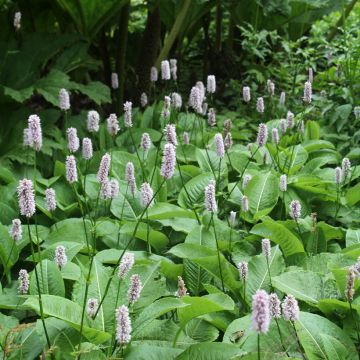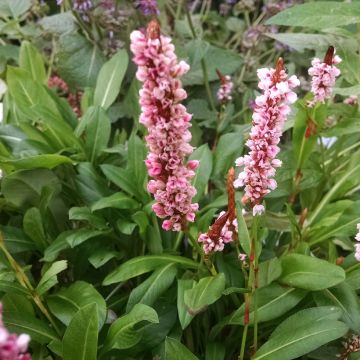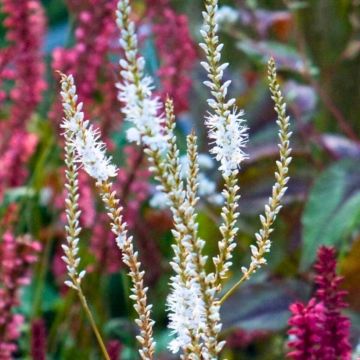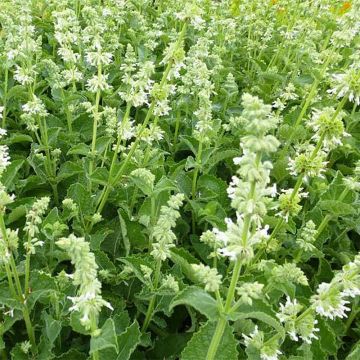

Persicaria amplexicaulis Inverleith - Mountain Fleece


Persicaria amplexicaulis Inverleith - Mountain Fleece


Persicaria amplexicaulis Inverleith - Mountain Fleece


Persicaria amplexicaulis Inverleith - Mountain Fleece
Persicaria amplexicaulis Inverleith - Mountain Fleece
Persicaria amplexicaulis Inverleith
Red Bistort, Mountain Fleece
Small pruning
Catherine B., 19/11/2018
Special offer!
Receive a €20 voucher for any order over €90 (excluding delivery costs, credit notes, and plastic-free options)!
1- Add your favorite plants to your cart.
2- Once you have reached €90, confirm your order (you can even choose the delivery date!).
3- As soon as your order is shipped, you will receive an email containing your voucher code, valid for 3 months (90 days).
Your voucher is unique and can only be used once, for any order with a minimum value of €20, excluding delivery costs.
Can be combined with other current offers, non-divisible and non-refundable.
Home or relay delivery (depending on size and destination)
Schedule delivery date,
and select date in basket
This plant carries a 12 months recovery warranty
More information
We guarantee the quality of our plants for a full growing cycle, and will replace at our expense any plant that fails to recover under normal climatic and planting conditions.
Would this plant suit my garden?
Set up your Plantfit profile →
Description
The Persicaria amplexicaulis 'Inverleith' is currently the smallest of all perennial knotweeds and as such a variety whose vigor is easily controlled. Therefore, it is ideal for borders and small spaces. This pretty variety with dark green foliage and a flexible habit produces, in the second part of summer, a quantity of short spikes of a delightful purplish pink to raspberry red. Very hardy, it is easily grown in good garden soil that retains moisture, even clayey, in a sunny or semi-shady position.
Persicaria or Polygonum amplexicaule 'Inverleith' is a plant from the family of polygonaceae. It is a horticultural selection appreciated for its moderate growth, derived from a botanical species native to the Himalayas. This rhizomatous perennial plant, more or less deciduous or semi-evergreen, forms a clump that will not exceed 40 cm (16in) in height when flowering, with a spread of 50 cm (20in). It spreads rather quickly, depending on the richness of the soil, and can eventually form a beautiful low ground cover after several years. Very floriferous, this knotweed produces at the axil of the leaves, located at the end of reddish stems, numerous very short and open spikes, composed of a multitude of small red flowers that turn more purplish pink when they open, with a matte finish. The flowering is continuous from July to September, if the soil does not dry out too much. The leaves, borne by sturdy stems, are wide and lanceolate, measuring 6-8 cm (2-3in) long, stem-clasping, dark green and vibrant, villous on the underside, and often become purple in autumn.
Like astrantias, knotweeds are very popular plants, thanks to their good adaptation to cold and humid climates and their sleek appearance that suits contemporary gardens as well as rustic and romantic flowerbeds. They form, along with grasses such as Miscanthus and Panicum, stunning autumn scenes. Thanks to its low and spreading habit, Polygonum 'Inverleith' can be used as an edging plant for paths or flowerbeds, in semi-shady areas of the garden. Provide it with sturdy companions that it won't smother. It likes rich and heavy, even very moist, soils and can be grown independently on sunny banks of a pond, along a sunken path, or in a cool understory at the base of trees. Asters, echinaceas, Stachys monierii 'Hummelo' and Sanguisorba 'Red Thunder', for example, are good companions for knotweeds, in the garden or in bouquets as they also flower until autumn.
Report an error about the product description
Persicaria amplexicaulis Inverleith - Mountain Fleece in pictures




Flowering
Foliage
Plant habit
Botanical data
Persicaria
amplexicaulis
Inverleith
Polygonaceae
Red Bistort, Mountain Fleece
Cultivar or hybrid
Other Persicaria
View all →Planting and care
The 'Inverleith' Persicaria amplexicaulis thrives in sunny or semi-shady exposure. It is a very easy plant to grow, it even tolerates moderate drought if the soil is deep. Plant it in any type of soil, as long as it is fresh, clayey or humiferous, even marshy, in spring or autumn, in groups to create a mass effect. Enrich the soil with organic fertilizer at the start of the vegetation, as it is a voracious plant. Control its growth so that it does not harm neighboring plants. Mulch the soil in June in regions where the summer is hot and dry. Divide the clumps in October every three years and replant the plants in another part of the garden.
Planting period
Intended location
Care
-
, onOrder confirmed
Reply from on Promesse de fleurs
Similar products
Haven't found what you were looking for?
Hardiness is the lowest winter temperature a plant can endure without suffering serious damage or even dying. However, hardiness is affected by location (a sheltered area, such as a patio), protection (winter cover) and soil type (hardiness is improved by well-drained soil).

Photo Sharing Terms & Conditions
In order to encourage gardeners to interact and share their experiences, Promesse de fleurs offers various media enabling content to be uploaded onto its Site - in particular via the ‘Photo sharing’ module.
The User agrees to refrain from:
- Posting any content that is illegal, prejudicial, insulting, racist, inciteful to hatred, revisionist, contrary to public decency, that infringes on privacy or on the privacy rights of third parties, in particular the publicity rights of persons and goods, intellectual property rights, or the right to privacy.
- Submitting content on behalf of a third party;
- Impersonate the identity of a third party and/or publish any personal information about a third party;
In general, the User undertakes to refrain from any unethical behaviour.
All Content (in particular text, comments, files, images, photos, videos, creative works, etc.), which may be subject to property or intellectual property rights, image or other private rights, shall remain the property of the User, subject to the limited rights granted by the terms of the licence granted by Promesse de fleurs as stated below. Users are at liberty to publish or not to publish such Content on the Site, notably via the ‘Photo Sharing’ facility, and accept that this Content shall be made public and freely accessible, notably on the Internet.
Users further acknowledge, undertake to have ,and guarantee that they hold all necessary rights and permissions to publish such material on the Site, in particular with regard to the legislation in force pertaining to any privacy, property, intellectual property, image, or contractual rights, or rights of any other nature. By publishing such Content on the Site, Users acknowledge accepting full liability as publishers of the Content within the meaning of the law, and grant Promesse de fleurs, free of charge, an inclusive, worldwide licence for the said Content for the entire duration of its publication, including all reproduction, representation, up/downloading, displaying, performing, transmission, and storage rights.
Users also grant permission for their name to be linked to the Content and accept that this link may not always be made available.
By engaging in posting material, Users consent to their Content becoming automatically accessible on the Internet, in particular on other sites and/or blogs and/or web pages of the Promesse de fleurs site, including in particular social pages and the Promesse de fleurs catalogue.
Users may secure the removal of entrusted content free of charge by issuing a simple request via our contact form.
The flowering period indicated on our website applies to countries and regions located in USDA zone 8 (France, the United Kingdom, Ireland, the Netherlands, etc.)
It will vary according to where you live:
- In zones 9 to 10 (Italy, Spain, Greece, etc.), flowering will occur about 2 to 4 weeks earlier.
- In zones 6 to 7 (Germany, Poland, Slovenia, and lower mountainous regions), flowering will be delayed by 2 to 3 weeks.
- In zone 5 (Central Europe, Scandinavia), blooming will be delayed by 3 to 5 weeks.
In temperate climates, pruning of spring-flowering shrubs (forsythia, spireas, etc.) should be done just after flowering.
Pruning of summer-flowering shrubs (Indian Lilac, Perovskia, etc.) can be done in winter or spring.
In cold regions as well as with frost-sensitive plants, avoid pruning too early when severe frosts may still occur.
The planting period indicated on our website applies to countries and regions located in USDA zone 8 (France, United Kingdom, Ireland, Netherlands).
It will vary according to where you live:
- In Mediterranean zones (Marseille, Madrid, Milan, etc.), autumn and winter are the best planting periods.
- In continental zones (Strasbourg, Munich, Vienna, etc.), delay planting by 2 to 3 weeks in spring and bring it forward by 2 to 4 weeks in autumn.
- In mountainous regions (the Alps, Pyrenees, Carpathians, etc.), it is best to plant in late spring (May-June) or late summer (August-September).
The harvesting period indicated on our website applies to countries and regions in USDA zone 8 (France, England, Ireland, the Netherlands).
In colder areas (Scandinavia, Poland, Austria...) fruit and vegetable harvests are likely to be delayed by 3-4 weeks.
In warmer areas (Italy, Spain, Greece, etc.), harvesting will probably take place earlier, depending on weather conditions.
The sowing periods indicated on our website apply to countries and regions within USDA Zone 8 (France, UK, Ireland, Netherlands).
In colder areas (Scandinavia, Poland, Austria...), delay any outdoor sowing by 3-4 weeks, or sow under glass.
In warmer climes (Italy, Spain, Greece, etc.), bring outdoor sowing forward by a few weeks.



















































